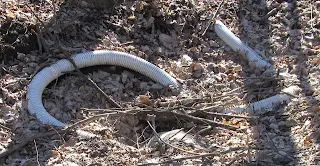"What is you climate zone? 5 or 6? How does the Asian Pear do in your climate? I'm in a 5 in the SW WI and wonder if it will thrive."
 |
| Zone maps available HERE |
My location is very exposed. I get much wind and lots of radiant heat loss on clear nights. Due to the elevation I do not have an issue with the coldest air puddling up on the coldest, clear still nights.
I have had winter damage on some of my Asian pears.
 |
| Not my photo |
I also had twig death after one test winter. The tree recovered and bore a partial crop that year.
Cultural practices
This is all pretty standard stuff for northern climates.
 |
| I think perforated, white drain tile would make good tree wrap in cold climates. It becomes critical to control rodents when you are providing them with predator-proof housing. |
- Use hardy rootstocks. If Pyrus calleryana (not very hardy) is your only choice then bury the graft union a couple of inches below the soil line. Otherwise, plant with the graft union one or two inches above the soil line.
- Plant the tree where it will get the maximum amount of sunlight per day. Sunlight equals ripe fruit. Sunlight equals twigs and trunks chock full of carbohydrates that act as antifreeze. Sunlight is your friend!
- Wrap the trunk. I have used old newspapers, dogfood bags, bags that contained concrete mix, brown paper bags, red rosin paper, cardboard pizza boxes. They all worked.
- Control rodent populations. Cage against deer and moose browsing if necessary.
- Control the fruit load. Trying to ripen too much fruit means a winter killed tree.
- Make sure you have a more-than-ample supply of potassium.
- Manage nitrogen and water so you get about three feet of growth in a non-fruiting tree and eighteen inches of growth in fruiting tree.
- Do not apply high nitrogen fertilizers after June first.
- Do not prune before March first. By March first you will have some idea of how severe the winter was. Also, leaving branches in-place provides some shielding from radiant heat loss and they mutually protect each other.
- Asian pears are vulnerable to overbearing. You will have branches break. The trees will recover.
- Do not let the tree touch steel wire or posts.
- Secure the tree so it does not get wind-whipped.
There are three kinds of "Asian" pears.
The kind that most people think about is Pyrus pyrifolia. The majority of the "Asian" pears in the super market are this species. Many selections are absolutely delicious. For the most part these are very grower-friendly trees. They almost try too hard to make you happy.
The hardiest "Asian" pears are Pyrus ussuriensis. Most of these pears are not so great for quality.
The third group is a huge, messy swarm of "hybrids". If you look through this list generated by the Agricultural Research Station you will see that many of the most cold hardy pears are hybrids. The list is not a "clean" list because it includes cultivars that are 'NOT COLD HARDY". My guess is that the summer intern who assembled this list did not proof read it. They simply mined the database looking for the string "*COLD HARDY*". Caveat emptor.
While there is not much agreement, there is some data that suggests that Shinseiki and Korean Giant are two of the hardier Pyrus pyrifolia cultivars.
For example, the link for Shinseiki states:
Cold Hardy. Survived and fruited for several years in USDA zone 4A near St. Cloud Minnesota. -- D. Griffin, 2005
Perhaps coincidentally, both Korean Giant and Shinseiki share Chojuro as a parent. Chojuro is Mrs ERJ's favorite Asian Pear by a very large margin.
As a bonus, here is a Canadian source of some hardy pears...including some of Russian origins.
Loren: I hope you found this helpful.


It was, thanks Joe.
ReplyDeleteMy location in the Driftless Region allows me a Southern exposure sloping to the SE and a great deal of protection from out of season frosts and cold temps. Trees and the slope block prevailing westerly winds. As a retired landscape contractor, I'm familiar with horticulture practices. FYI, my favorite winter wrap is still the old fashioned crepe paper/tar wraps. Doesn't allow bugs and protects against winter sun scald. A heavy cow manure mulch pulled away from the trunk seems to work well too. I do love the midwest and soils. My former work was in Colorado/Australia and the Middle East and climate and soils were a real challenge.
The biggest help was the cultivars most useful to you.